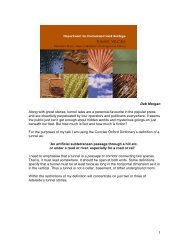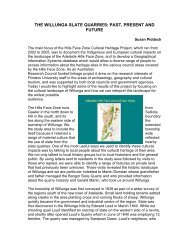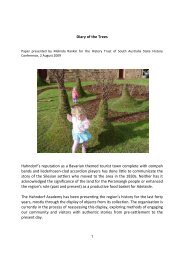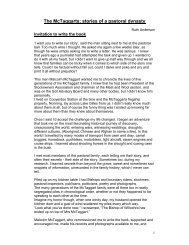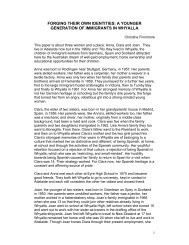Southward Bound Information - History SA
Southward Bound Information - History SA
Southward Bound Information - History SA
Create successful ePaper yourself
Turn your PDF publications into a flip-book with our unique Google optimized e-Paper software.
From 1836 to December 1840 more than 100 ships arrived in South Australia<br />
conveying passengers from the Northern Hemisphere.<br />
Many early emigrants travelled to South Australia at the expense of the Land<br />
Fund, in ships provided by the Colonisation Commission. They described<br />
themselves as labourers or servants but many had no intentions of filling such<br />
positions on arrival. Some were planning to buy small farming blocks, while others<br />
were tradesmen intent on developing a business of their own in Adelaide.<br />
A financial crisis in 1840 caused the suspension of all assisted passages. Although<br />
these were resumed in 1845, the system did not regain full momentum until 1849.<br />
During this time, there was a steady number of people arriving, particularly from<br />
Scotland. Some passengers were financed by private organizations; others paid<br />
their own fares.<br />
The discovery, between 1842 and 1845, of reserves of copper in South Australia<br />
triggered an extensive canvassing in the German states for emigration to South<br />
Australia. By the end of the 1840’s, the flow of new arrivals from all countries had<br />
become overwhelming and the arrival of four ships per week was not uncommon.<br />
GOVERNMENT CONTROL<br />
Following the financial crisis of 1840, the British Government stepped in and<br />
emigration to South Australia was supervised by the Colonisation Commission,<br />
which was concerned with migration to all British colonies. Emigration to South<br />
Australia became a matter of government policy, rather than being based on the<br />
needs of the colony as had previously been the case.<br />
In 1848 it was officially decided to foster the emigration of poverty stricken<br />
labourers, women and orphans to South Australia. The plan went ahead despite a<br />
huge public outcry.<br />
With the British Government accepting emigration as their responsibility,<br />
systematic colonisation, as set out by Wakefield, passed from the scene.<br />
Emigration was now firmly controlled by the government. Some emigrants<br />
preferred to pay their own way, but free or assisted emigration now hinged, to a<br />
large extent on government planning. No longer were intending emigrants selected<br />
with the aim of assisting wealthy landowners.<br />
By 1850 the carefully worked out theories that had set in motion the plans to form<br />
South Australia were completely abandoned.<br />
REASONS FOR EMIGRATION



